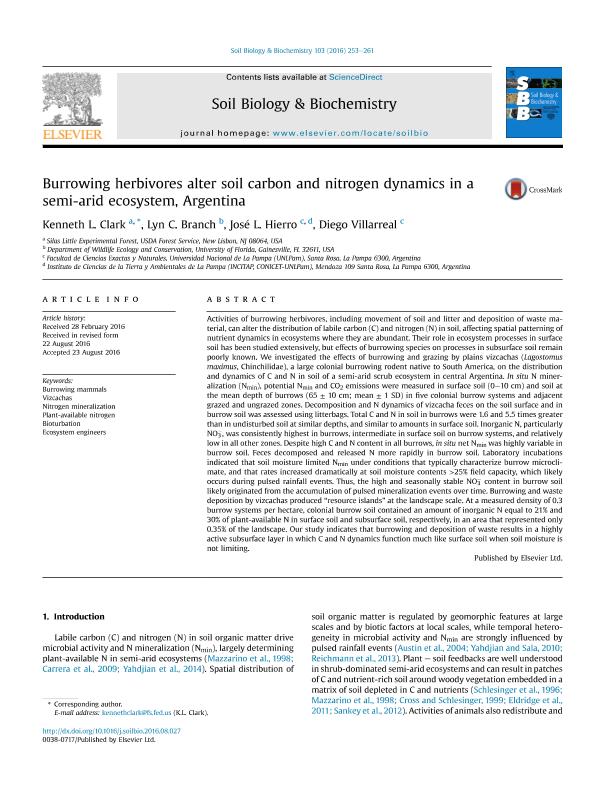Mostrar el registro sencillo del ítem
dc.contributor.author
Clark, Kenneth L.
dc.contributor.author
Branch, Lyn Clarke

dc.contributor.author
Hierro, Jose Luis

dc.contributor.author
Villarreal, Diego

dc.date.available
2017-06-30T13:38:34Z
dc.date.issued
2016-12
dc.identifier.citation
Clark, Kenneth L.; Branch, Lyn Clarke; Hierro, Jose Luis; Villarreal, Diego; Burrowing herbivores alter soil carbon and nitrogen dynamics in a semi-arid ecosystem, Argentina; Elsevier; Soil Biology And Biochemistry; 103; 12-2016; 253-261
dc.identifier.issn
0038-0717
dc.identifier.uri
http://hdl.handle.net/11336/19243
dc.description.abstract
Activities of burrowing herbivores, including movement of soil and litter and deposition of waste material, can alter the distribution of labile carbon (C) and nitrogen (N) in soil, affecting spatial patterning of nutrient dynamics in ecosystems where they are abundant. Their role in ecosystem processes in surface soil has been studied extensively, but effects of burrowing species on processes in subsurface soil remain poorly known. We investigated the effects of burrowing and grazing by plains vizcachas (Lagostomus maximus, Chinchilidae), a large colonial burrowing rodent native to South America, on the distribution and dynamics of C and N in soil of a semi-arid scrub ecosystem in central Argentina. In situ N mineralization (Nmin), potential Nmin and CO2 emissions were measured in surface soil (0–10 cm) and soil at the mean depth of burrows (65 ± 10 cm; mean ± 1 SD) in five colonial burrow systems and adjacent grazed and ungrazed zones. Decomposition and N dynamics of vizcacha feces on the soil surface and in burrow soil was assessed using litterbags. Total C and N in soil in burrows were 1.6 and 5.5 times greater than in undisturbed soil at similar depths, and similar to amounts in surface soil. Inorganic N, particularly NO3−, was consistently highest in burrows, intermediate in surface soil on burrow systems, and relatively low in all other zones. Despite high C and N content in all burrows, in situ net Nmin was highly variable in burrow soil. Feces decomposed and released N more rapidly in burrow soil. Laboratory incubations indicated that soil moisture limited Nmin under conditions that typically characterize burrow microclimate, and that rates increased dramatically at soil moisture contents >25% field capacity, which likely occurs during pulsed rainfall events. Thus, the high and seasonally stable NO3− content in burrow soil likely originated from the accumulation of pulsed mineralization events over time. Burrowing and waste deposition by vizcachas produced “resource islands” at the landscape scale. At a measured density of 0.3 burrow systems per hectare, colonial burrow soil contained an amount of inorganic N equal to 21% and 30% of plant-available N in surface soil and subsurface soil, respectively, in an area that represented only 0.35% of the landscape. Our study indicates that burrowing and deposition of waste results in a highly active subsurface layer in which C and N dynamics function much like surface soil when soil moisture is not limiting.
dc.format
application/pdf
dc.language.iso
eng
dc.publisher
Elsevier

dc.rights
info:eu-repo/semantics/openAccess
dc.rights.uri
https://creativecommons.org/licenses/by-nc-sa/2.5/ar/
dc.subject
Borrowing Mammals
dc.subject
Vizcachas
dc.subject
Nitrogen Mineralization
dc.subject
Plant-Available Nitrogen
dc.subject
Bioturbation
dc.subject
Ecosystem Engineers
dc.subject.classification
Ecología

dc.subject.classification
Ciencias Biológicas

dc.subject.classification
CIENCIAS NATURALES Y EXACTAS

dc.title
Burrowing herbivores alter soil carbon and nitrogen dynamics in a semi-arid ecosystem, Argentina
dc.type
info:eu-repo/semantics/article
dc.type
info:ar-repo/semantics/artículo
dc.type
info:eu-repo/semantics/publishedVersion
dc.date.updated
2017-06-29T13:59:26Z
dc.journal.volume
103
dc.journal.pagination
253-261
dc.journal.pais
Países Bajos

dc.journal.ciudad
Ámsterdam
dc.description.fil
Fil: Clark, Kenneth L.. United States Department of Agriculture; Estados Unidos
dc.description.fil
Fil: Branch, Lyn Clarke. University of Florida. Department of Wildlife Ecology and Conservation; Estados Unidos
dc.description.fil
Fil: Hierro, Jose Luis. Consejo Nacional de Investigaciones Científicas y Técnicas. Instituto de Ciencias de la Tierra y Ambientales de La Pampa. Universidad Nacional de La Pampa. Facultad de Ciencias Exactas y Naturales. Instituto de Ciencias de la Tierra y Ambientales de La Pampa; Argentina
dc.description.fil
Fil: Villarreal, Diego. Universidad Nacional de La Pampa. Facultad de Ciencias Exactas y Naturales; Argentina
dc.journal.title
Soil Biology And Biochemistry

dc.relation.alternativeid
info:eu-repo/semantics/altIdentifier/url/http://www.sciencedirect.com/science/article/pii/S0038071716302152
dc.relation.alternativeid
info:eu-repo/semantics/altIdentifier/doi/http://dx.doi.org/10.1016/j.soilbio.2016.08.027
Archivos asociados
